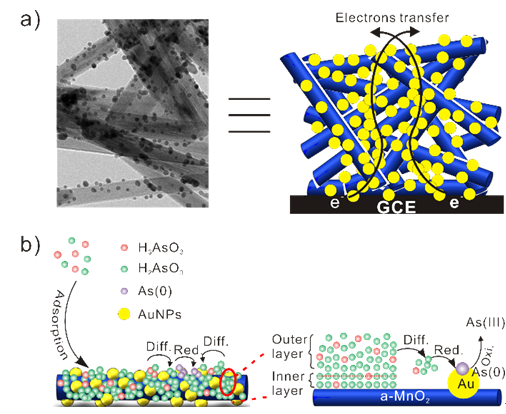Electrochemical analytical tools have been widely investigated for toxic As(III) detection and the achievements have also been so fruitful. However, it seems that a truth was ignored during the measurements arsenic with electrochemical method, i.e., the speciation of arsenic is different at different pH values, which would affect the accuracy of the arsenic detection. For the relatively strong toxic As(III), the nonionic arsenic (H3AsO3) is the dominant species at the pH below 7.0.
When the pH is higher than 7.0, ionized As(III) species H2AsO3− begins to form (very little at pH 7.0−8.0) and increases gradually with the increase of pH value. When the pH value reaches 10.0, the ionized As(III) species HAsO32− is formed. When the pH value further increases to 12.0, ionized As(III) species AsO33− emerges. In general, the environment of the groundwater is weakly alkaline, the ionized As(III) species (H2AsO3−) and nonionic arsenic (H3AsO3) are the dominant species. Therefore, considering the change of As(III) speciation in different pH conditions, to develop a reliable method for the detection of As(III) in alkaline media might be more meaningful for practical applications.
Recently, a study team led by Prof. HUANG Xingjiu and Prof. LIU Jinhuai in Institute of Intelligent Machines (IIM), Hefei Institutes of Physical Science, explored the electrochemical detection of trace arsenic(III) by nanocomposite of nanorod-like α‑MnO2 decorated with ∼5 nm Au nanoparticles: considering the change of arsenic speciation. The paper was accepted for publication by Analytical Chemistry. http://pubs.acs.org/journal/ancham
In this work, overcoming the change of arsenic(III) speciation at different pH conditions, a new nanocomposite of nanorod-like α-MnO2 decorated with ∼5 nm AuNPs (AuNPs/α-MnO2) has been found to be used for reliable detection of ultratrace
original As(III) speciation in real water samples in alkaline media (pH 9.0). Taking the different As(III) speciation at various pH media into account, As(III) adsorption isotherms data are obtained at different pH media, which are all better fitted by the Freundlich model, indicating a multilayer adsorption behavior of As(III) onto the AuNPs/α-MnO2 nanocomposite. Moreover, adsorption experiments and XPS results quantificationally reveal the largest amount of adsorbed As(III) on the AuNPs/α-MnO2 nanocomposite at pH 9.0 Na2CO3-NaHCO3 buffer solution. Accordingly, such a nanocomposite works based on a strategy combining excellent multilayer adsorption of nanorod-like α-MnO2 with robust electrocatalytic ability of decorated ∼5 nm AuNPs. With the consideration of its improved sensitivity, limit of detection, ultrahigh anti-interference ability, and the property that As(III) can maintain the original speciation in alkaline media, AuNPs/α-MnO2 nanocomposite is expected to be more accurate and reliable for online monitoring of As(III) in real water samples.
This work was supported by the National Natural Science Foundation of China (Grants U1532123, 21277146, 61573334, 21377131, 21475133, and 61474122).

Figure 1. a) Pathway of electron transfer through the interconnection of AuNPs and b) Schematic of in situ electrocatalysis for As(III) detection on AuNPs/α-MnO2
nanocomposite modified GCE in alkaline media (pH 9.0) based on multilayer adsorption of nanorod-like α-MnO2 and excellent electrocatalysis of ∼5 nm AuNPs

Figure 2. a) Typical SWASV responses of AuNPs/α-MnO2/GCE for analysis of As(III) at pH 9.0 and pH 5.0 buffer solution, respectively. b) As(III) adsorption isotherms on AuNPs/α-MnO2 at different pH media. c) high-resolution XPS spectra of As3d signature region for AuNPs/α-MnO2 after As(III) absorption at different pH media.
(Imaged by YANG Meng)
Title: Electrochemical Detection of Trace Arsenic(III) by Nanocomposite of
Nanorod-Like α-MnO2 Decorated with ∼5 nm Au Nanoparticles: Considering the Change of Arsenic Speciation
Key words: Electrochemical detection, Arsenic speciation, AuNPs/α-MnO2
Prof. HUANG Xing-Jiu, Ph. D Principal Investigator
Institute of Intelligent Machines, Chinese Academy of Sciences, Hefei 230031, China
Tel: 86-551-6559-1167
Email: xingjiuhuang@iim.ac.cn
Article link: http://pubs.acs.org/doi/abs/10.1021/acs.analchem.6b02629